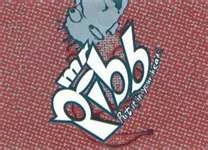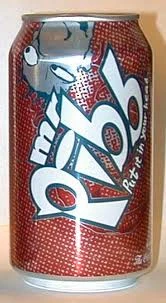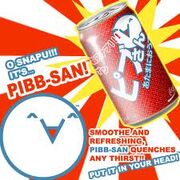
Mr. Pibb 1998-2001 American Logo
Beverage
Name: Mr. Pibb
Type: Pepper-Type Cola
manufacturer: The Coca-Cola Company
Origin: United States
Introduced: 1972
Discontinued: 2001 (In some parts of the United States, still in Japan.)
Color: Caramel
Related: Pibb Xtra, Pibb Zero, Dr. Pepper
Variants: Diet Mr. Pibb, Pibb Blue, Sugar Free Mr. Pibb
Mr. PiBB was a soft drink marketed by The Coca-Cola Company. It is no longer sold today in the U.S., but is still sold in Japan, and a few island countries. Variants of this soda have been made.
History
Mr. PiBB was invented in the summer of 1972 after The Coca-Cola Company had the intention of creating a drink that would rival the growing success of Dr Pepper in Southern markets. After losing a law suit filed by Dr Pepper manufacturers who disputed Coke's original use of the name "Peppo," Coca-Cola settled on the name "Mr. PiBB" for important brand-identification purposes. A combination of an abbreviated formal title and a one-word surname would serve the purpose of helping consumers associate the new product with the "Dr Pepper-type" flavor. On June 28, 1972, Coke began test-marketing Mr. PiBB in Texas and Mississippi. Among the first cities chosen were Waco and Temple, Texas and Columbus, Starkville and West Point, Mississippi. The following week, the new product was introduced in Texarkana, Texas and within a couple of months, Mr. PiBB appeared in Houston, Galveston, and Tyler, Texas. Later that year, they extended distribution to include some Southern and Mid-Western states (Arkansas, Tennessee, Kansas and Georgia.)
Within a couple of years, Mr. PiBB was available in most states East of the Mississippi River and some West-Coast states including California, Oregon and Washington.

A 1998 can of Mr. Pibb.
Even though Mr. PiBB was unable to equal the overwhelmingly tremendous popularity of Dr Pepper, Coke was able to gain valuable soft drink market-share points during this time through the introduction of the new brand. In the first several years of Mr. PiBB's existence, Coke placed the description, "Blended Flavored (Cherry and Other Flavorings) Carbonated Beverage" on all Mr. PiBB products for consumer identification purposes. Mr. PiBB was first marketed with the slogan "It Goes Down Good," which was printed on the original brown and yellow steel cans and point of sale promotional materials. Some other advertising pieces during this time included variations of the slogan, namely "With the Easy Taste that Goes Down Good," and "Smooth and Easy It Goes Down Good." "Rise Up With Mr. PiBB" was also used. The first internal Coca-Cola Company promotion for the brand was titled "Private Air Force for Mr. PiBB." Coke authorized the production of gift items with the "Private Air Force for Mr. PiBB" logo to be used as incentives for Coke representatives to meet sales goals, set up displays and successfully merchandise the product. In 1975, Coke changed the color of the Mr. PiBB can to red. This was due to consumer preference research which concluded that the original brownish color used gave off the impression to the consumer that Mr. PiBB was a form of root beer, a dangerous marketing mistake since Coke's goal was to capitalize on Dr Pepper's taste distinction. Throughout the late 1970s, Coke spent millions of dollars trying to bolster Mr. PiBB name recognition among consumers. Comedians George Burns and David Brenner were hired to shoot Mr. Pibb television commercials. The Mr. Pibb logo was posted in Motocross racing events and Joie Chitwood stunt shows with hopes of picking up greater market share in one of the most important regional markets for spicy cherry soft drinks - the US South. There was a sharp increase in print, television and radio advertising, using new slogans such as "Have A PiBB Mister."

Diet Mr. Pibb.
In April 1980, Coke, intending to increase sales, redesigned the formula of Mr. PiBB and marketed cans and packaging with "New Taste" printed in bold yellow lettering. Coca-Cola conducted the "1980's: A New Taste Odyssey" sweepstakes for their employees to encourage field support of the improved product.
However, Mr. PiBB was never able to threaten the predominance of Dr Pepper, which was a "first-to-market" product, establishing primary name-recognition among consumers in the "cherry-flavored" soft drink category. Dr Pepper had almost a 100-year head start to win over the minds of the average drinker. Some industry estimates have had Dr Pepper outselling Mr. PiBB at a ratio of 17-to-1 (much of this disparity, though, is due to Mr. PiBB's non-national distribution).
In the early 1980s, Coke realized an opportunity to form a strategic partnership with the Dr Pepper Company which exchanged use of superior Coca-Cola bottling facilities for a share in Dr Pepper sales profits. Only in regions of the country where Pepsi or 7up outbid Coke for this right did Coke resort to the production of Mr. PiBB. This limited production meant less time and energy spent by Coke on marketing for Mr. PiBB, which explains why Mr. PiBB promotional material and packaging from the 1980s and beyond is more difficult to find today.
The original Mr. PiBB logo - referred to as "Generation 1" - that was created in 1972 was used for over 18 years. With exception of a few color changes and the use of just "PiBB" in the late 1970s and 1980s, the font and style remained the same. In 1991, Coke decided to redesign the Mr. PiBB logo. This was a very short-lived design because of a law suit filed in late 1992 which alleged that the new diagonal styling on cans and bottles looked too much like Dr Pepper's. It was soon replaced by a new, fancier design in 1993. The next year, the Mr. PiBB head character was added to the 1993 design which again, only lasted for a couple years. It was at this time when the slogan "Put it in Your Head" was introduced and Coke placed Mr. PiBB in McDonald's fountain drink accounts nationwide. The Generation 5 design was adopted in 1996 (with minor revisions in 1998) and retained the "Put it in Your Head" concept.
Mr. PiBB has been produced in many different sizes of cans and bottles. Over the years, there have existed 8oz, 280ml, 12oz and 16oz steel and aluminum cans, as well as 8oz, 10oz, 300ml, 12oz, 16oz, 26oz, 32oz, 33.8oz (1 litre), 48oz, 64oz and 67.6oz (2 litre) glass bottles. Plastic bottles have also been made in 20oz, .5 litre, 1 litre and 2 litre sizes.
On June 26, 2001, the history of Mr. PiBB changed again. The Coca Cola Company introduced a new version of Mr. PiBB - "Pibb Xtra" - into several Texas test-markets, including Houston and Dallas. Several months later, Pibb Xtra made its way into other states, namely Kansas and Missouri. Currently, the new version exists in multiple prominent bottling territories.
Pibb Xtra is not a diet beverage, nor does it contain any additional caffeine or sugar; it is simply a new flavor. It is available in 12oz aluminum cans (singles, 4-packs, 12-packs and 15-packs), 20oz PET plastic bottles, .5 litre PET plastic bottles (6-packs), 1 litre PET plastic bottles and 2 litre PET plastic bottles.
Facts from http://www.pibbthug.com
Mr. Pibb was as available at Wendy's fast food restaurant in New Hampshire as a fountain drink until early 2015.
Mr. Pibb can still be bought in many parts of Wisconsin as of 2016 in 20 ounce bottles.

Current Japanese Mr. Pibb, in an advertisement. Known in Japan as Pibb-San.
In Popular Culture
Many fans of Mr. Pibb have made petitions on websites to recontinue the fallen soda. Even in Seth Macfarlane's animated television show "American Dad", the main character wants to stop the discontinuation of Mr. Pibb. Many Facebook pages of the have been made, and other fans have resorted to Pibb Xtra. The Dr. Pepper fans are mostly main rivals of this soda, some people don't mind drinking both, as told by surveys. A few countries still distribute this product, though Mr. Pibb was mostly marketed in the U.S.
Nutrition
A 67.6 ounce (Large Bottle) serving of Mr. Pibb contains 388 calories, all of which are from sugar. There are 104 mg of sodium, and 104 grams of carbohydrates.[1]
Nutrition Facts
Serving Size 1 can
Servings Per Container 1
% Daily Value*
Total Fat 0g 0%
Sodium 26 mg 1%
Total Carbohydrate 26g 9%
Protein 0g
Caffeine 40.8 mg
Amount Per Serving
Calories 97
Not a significant source of calories from fat, saturated fat, trans fat, cholesterol, dietary fiber, vitamin A, vitamin C, calcium and iron.
*Percent Daily Values are based on a 2,000 calorie diet*
=References=
2. ^ http://www.pibbthug.com
3. ^ http://www.cocacola.com
4. ^ http://thecoca-colacompany.com/ourcompany/historybottling.html
Template:Coca-Cola brands
Template:Pepper sodas
ja:ミスター・ピブ